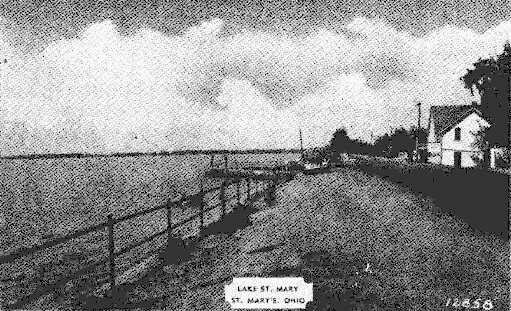|
this little settlement. After burning the stockade and robbing all merchandise, the Indians boiled and ate its proprietor, "Old Brittain" as he had become known. The 24 English traders who were also there were placed in captivity and led back to the French city of Detroit. None made it or were ever heard from again.
In any case, the trading continued as new posts came into being. After George Rogers Clark destroyed the Shawnee town at Piqua in 1782, the Indians retreated to Saint Marys where they were supplied by a trader whose name seems to be lost. However, the Shawnees had in captivity a 12 year old white boy, George Ash. Ash lived here as an Indian for almost two years before his tribe moved on down the Saint Marys river toward Fort Wayne. To George Ash, even though living as a red-man, must go the recognition of being the first white resident of what is now Saint Marys. Certainly he was preferable to the next, for he was followed by the infamous renegade James Girty. Girty, a Pennsylvanian, had been serving in the Virginia Militia at the outbreak of the Revoluntionary War. He and his brothers, Simon and George, along with the McKees deserted the American cause in 1778 and went over to the British side. It is open to historical question whether these desertions were for British gold, resentment of the treatment of the Seneca tribe by the Arnerican forces or for personal conflict with certain superior officers. The Girtys had been captives of the Senecas for a number of years before their escape. They had witnessed the torture and slaying of their step-father, John Turner. James and Simon Girty were leaders in many raids against the white settlers coming into Ohio. They enjoyed the Indian life and warfare. A scalp was a scalp, and the British would pay well in whisky and supplies. Of the two of these, James was probably the better only because Simon was worse. More can be learned of this pair from other sources, but it was James Girty who engaged more in trade. He established a trading post in 1788 at the headwaters of the Saint Marys River near where the old Lutheran Cemetery is now located. Several times he packed his stores to flee into Indian country. First, when General Harmer lead a United States Army against the tribes. However? Harmer's route went to the east and he was so badly defeated at Fort Wayne. Later General St. Clair came north from Cincinnati with another army. This one was wiped out at present Fort Recovery. In 1794, General Mad Anthony |
Wayne came through on his way to Victory at the Battle of Fallen Timbers. One of his supply posts was the fort he built at Saint Marys. This time Girty had fled, but he left behind a name that took many years to erase. This place was known as Girty's Town for years and was still widely called by that name as Charles Murray, William Houston and John McCorkle set out that August day for Greenville, Ohio to file their "law stuff" and create the new town of Saint Marys.
Leaving the clearing that had been cut out by the builders of the forts and stockades, the men entered the forest. Here their trail was easier to follow. The virgin oaks, hickorys, beeches, towering maples and spreading elms had cast much shade over the soft springy ground that the second growth, the vines and the brambles had not had such favorable conditions to crowd out the pathway. The deep ruts cut into the soil by the many army wagons bringing supplies from Fort Greenville through the woods to Fort Saint Marys and the later built Fort Barbee left a mark so deep and distinct that many years later a settler would point them out to his children as General Wayne's Trail. From time to time, Murray would halt as he pointed out some place that had particular interest. Only a few miles had passed when he turned to his companions. "Now right over there a short piece is the Big Swamp. That's where those canal men say they're gonna make a lake. Takes water to run a canal. There's over a hundred good flowing springs in there, so they say they can build a dam over a mile long from high ground to high ground. Then they'll go a mile or so west and build another dam. Between the two dams they'll store water to float the boats. Can you just see that now! A great big lake out there almost a whole mile square ! " |
|
3
previous page |
4
next page |



virtual St. Marys, Ohio
© 1999 ridertown.com
Aloha
